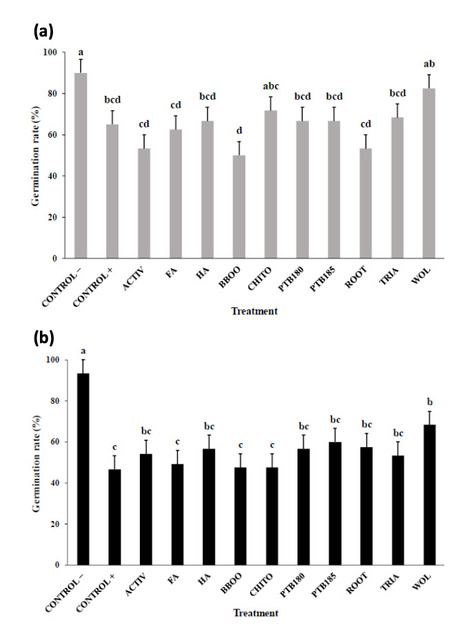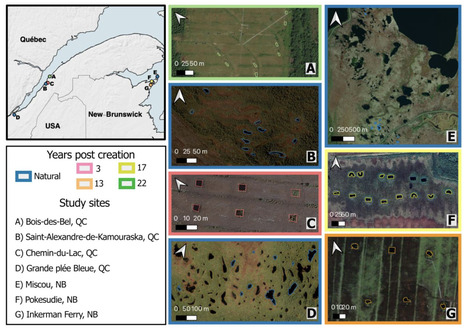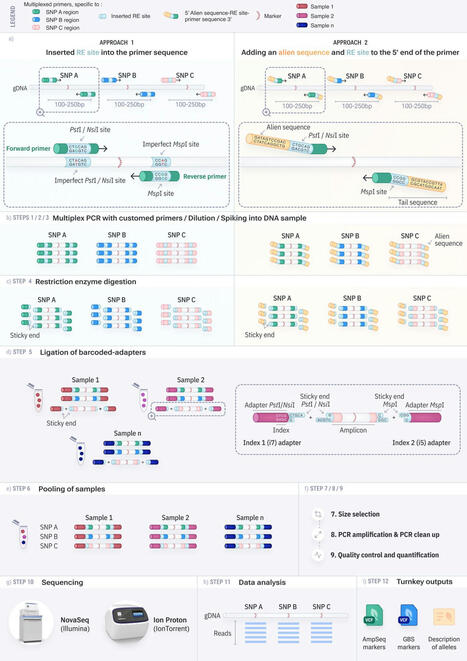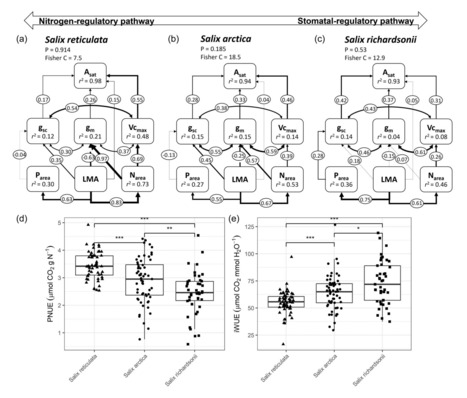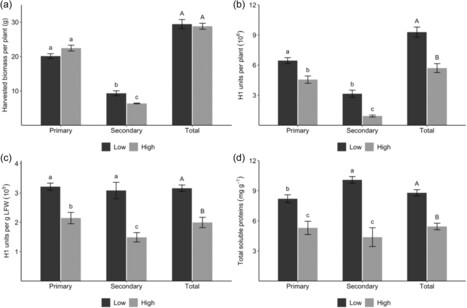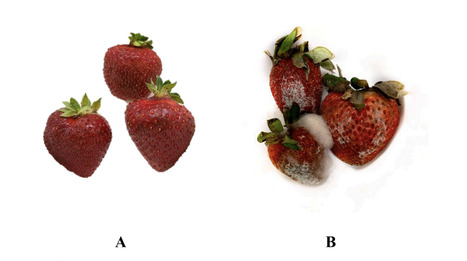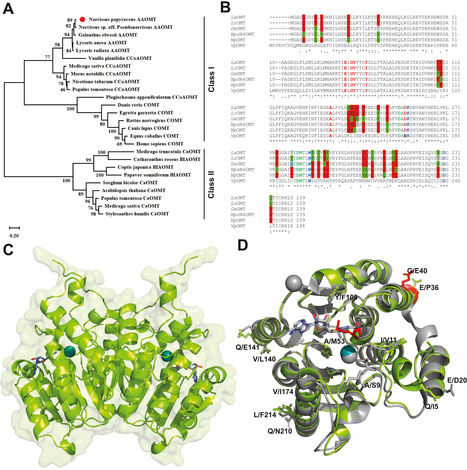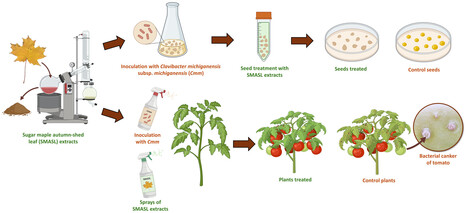 Your new post is loading...
 Your new post is loading...

|
Scooped by
ulcriv
November 11, 2024 6:04 PM
|
The lifecycle of fresh produce involves a sequence of biochemical events during their ontology, and these events are particularly significant for climacteric fruits. A high demand during ripening is observed in these plant products, which is reflected in a high rate of respiration and ethylene production. Increased respiratory demand triggers the activation of secondary pathways such as alternate oxidase, which do not experience critical increases in energy consumption in non-climacteric fruit. In addition, biochemical events produced by external factors lead to compensatory responses in fresh produce to counteract the oxidative stress caused by the former. The dynamics of these responses are accompanied by signaling, where reactive oxygen species play a pivotal role in fresh product cell perception. This review aims to describe the protection mechanisms of fresh produce against environmental challenges and how controlled doses of abiotic stressors can be used to improve quality and prolong their shelf-life through the interaction of stress and defense mechanisms.

|
Scooped by
ulcriv
November 11, 2024 5:52 PM
|
Ten products, commercially available as biostimulants or reported for their biostimulating properties, were tested under conventional and organic growing systems for their effects on mustard microgreens (Brassica juncea) grown in presence of abiotic (salt) or biotic (Pythium ultimum) stress. Drench application of wollastonite (calcium silicate) significantly improved the germination rate of mustard seeds sown in a substrate inoculated with P. ultimum in conventional growing system exclusively. In both growing systems, no significant effect of biostimulants was observed on the dry biomass or the proportion of healthy microgreens grown in presence of P. ultimum. None of the biostimulants significantly increased the germination rate of seeds exposed to a salinity stress in both growing systems while humic acid, triacontanol, chitosan, and Bacillus subtilis PTB185 significantly decreased the germination rate of seeds exposed to 40, 80 or 120 mM NaCl L-1 under conventional or organic management. Seed treatment with Trichoderma harzianum T-22 and humic acid resulted in microgreens with a significantly higher dry biomass when subjected to 40 and 80 mM NaCl L-1 under conventional and organic management, respectively. The study showed that the effects of the biostimulants vary from beneficial to detrimental and that plant response to biostimulants is influenced by the cultivation conditions.

|
Scooped by
ulcriv
November 11, 2024 5:41 PM
|
The widespread use of conventional pesticides for plant pathogen control poses significant risks to human health and the environment, and it is therefore crucial to develop environmentally friendly, human-safe alternatives to these products that offer a sustainable approach for crop protection. Here, we examined the potential of ethanolic extracts from four forest tree species for their antibacterial activity against the bacterial pathogen Pseudomonas syringae pv. tomato (Pst) and their ability to trigger effective defense responses in the model plant Arabidopsis thaliana. The extracts exhibited direct toxic effects against Pst and triggered the expression of defense-related genes naturally induced by oxidative stress cues or the defense elicitor salicylic acid in leaf tissue. The direct antibacterial effects of the tree extracts, together with their defense gene-inducing effects in planta, resulted in a strong host plant-protecting effect against Pst. These findings suggest the eventual effectiveness of forest tree extracts as plant protectants against the bacterial pathogen Pst. They also suggest the potential of these extracts as a sustainable, eco-friendly alternative to conventional pesticides for the management of economically important plant pathogens.

|
Scooped by
ulcriv
November 11, 2024 5:21 PM
|
In the last 25 years, several degraded peatlands in eastern Canada have been restored toward their natural structure. Pools are common in natural peatlands and are important habitats for unique flora and fauna. Because of their ecological value, pools have been created in some restored peatland sites. Nevertheless, the biogeochemistry of created pools in a restoration context has seldom been studied. The objective of our study is to characterize the biogeochemistry of created pools from restored peatlands and compare them with natural pools along a chronosequence since their creation. We measured different biogeochemical variables (pH, concentrations of nitrogen (N), phosphorus (P), dissolved organic carbon (DOC), dissolved organic matter (DOM), base cations—calcium (Ca), sodium (Na), magnesium (Mg), and potassium (K)—and dissolved gases—methane (CH4), carbon dioxide (CO2), and nitrous oxide (N2O)-) in 61 pools distributed over seven peatlands in eastern Canada. The sites represent a range of conditions, from natural to restored peatlands with pools ranging from 3 to 22 years old. Created and natural pools had distinctive biogeochemistry, with created pools being generally less acidic (pH >5) and 2.5 times more concentrated in nutrients (N and P) than in natural pools. DOC, N, P, dissolved gases, and base cations concentrations were lower in natural pools than in created pools, and varied between created sites. The oldest created pools (age >17 years) tend to approach the biogeochemical characteristics of natural pools, indicating that created pools may, over time, provide habitats with similar conditions to natural pools. A return of created pools to a natural pool-like biogeochemistry could thus inform on the success of peatland restoration.

|
Scooped by
ulcriv
November 11, 2024 5:14 PM
|
New selection methods, using trait-specific markers (marker-assisted selection (MAS)) and/or genome-wide markers (genomic selection (GS)), are becoming increasingly widespread in breeding programs. This new era requires innovative and cost-efficient solutions for genotyping. Reduction in sequencing cost has enhanced the use of high-throughput low-cost genotyping methods such as genotyping-by-sequencing (GBS) for genome-wide single-nucleotide polymorphism (SNP) profiling in large breeding populations. However, the major weakness of GBS methodologies is their inability to genotype targeted markers. Conversely, targeted methods, such as amplicon sequencing (AmpSeq), often face cost constraints, hindering genome-wide genotyping across a large cohort. Although GBS and AmpSeq data can be generated from the same sample, an efficient method to achieve this is lacking. In this study, we present the Genome-wide & Targeted Amplicon (GTA) genotyping platform, an innovative way to integrate multiplex targeted amplicons into the GBS library preparation to provide an all-in-one cost-effective genotyping solution to breeders and research communities. Custom primers were designed to target 23 and 36 high-value markers associated with key agronomical traits in soybean and barley, respectively. The resulting multiplex amplicons were compatible with the GBS library preparation enabling both GBS and targeted genotyping data to be produced efficiently and cost-effectively. To facilitate data analysis, we have introduced Fast-GBS.v3, a user-friendly bioinformatic pipeline that generates comprehensive outputs from data obtained following sequencing of GTA libraries. This high-throughput low-cost approach will greatly facilitate the application of DNA markers as it provides required markers for both MAS and GS in a single assay.

|
Scooped by
ulcriv
November 11, 2024 3:50 PM
|
Increases in shrub height, biomass and canopy cover are key whole-plant features of warming-induced vegetation change in tundra. We investigated leaf functional traits underlying photosynthetic capacity of Arctic shrub species, particularly its main limiting processes such as mesophyll conductance. In this nutrient-limited ecosystem, we expect leaf nitrogen concentration to be the main limiting factor for photosynthesis. We measured the net photosynthetic rate at saturated light (Asat) in three Salix species throughout a glacial valley in High-Arctic tundra and used a causal approach to test relationships between leaf stomatal and mesophyll conductances (gsc, gm), carboxylation capacity (Vcmax), nitrogen and phosphorus concentration (Narea, Parea) and leaf mass ratio (LMA). Arctic Salix species showed no difference in Asat compared to a global data set, while being characterized by higher Narea, Parea and LMA. Vcmax, gsc and gm independently increased Asat, with Vcmax as its main limitation. We highlighted a nitrogen-influenced pathway for increasing photosynthesis in the two prostrate mesic habitat species. In contrast, the erect wetland habitat Salix richardsonii mainly increased Asat with increasing gsc. Overall, our study revealed high photosynthetic capacities of Arctic Salix species but contrasting regulatory pathways that may influence shrub ability to respond to environmental changes in High Arctic tundra.

|
Scooped by
ulcriv
November 11, 2024 3:34 PM
|
This study investigated the effect of black soldier fly larvae (BSFL) frass derived from BSFL reared on a diet composed of fruit/vegetable/bakery/brewery residues (FVBB diet) and on the Gainesville diet (GV diet) on the development of tomato (Solanum lycopersicum) Fusarium wilt caused by Fusarium oxysporum f. sp. lycopersici (FOL). Tomato plants were grown in a substrate inoculated with FOL that was amended (10%, v:v) or not (control) with either a commercial compost, pasteurized (70 °C for 1 h) frass from BSFL reared on a FVBB diet, non-pasteurized frass from BSFL reared on a FVBB diet, pasteurized frass from BSFL reared on the GV diet, or non-pasteurized frass from BSFL reared on the GV diet. The results show that frass from BSFL reared on the GV diet, irrespective of pasteurization, inhibited FOL root colonization and reduced the severity of tomato Fusarium wilt to a far greater extent than frass from BSFL reared on a FVBB diet and commercial compost made of peat, seaweed, and shrimps. This study suggests that BSFL frass, depending on the larval rearing diet, has the potential to serve as a pasteurized or non-pasteurized soil amendment with prophylactic properties against FOL in tomato plants, opening new avenues of research for the valorization of BSFL frass.

|
Scooped by
ulcriv
November 11, 2024 2:45 PM
|
Plant molecular farming is currently operating a transition from soil-based cultures toward hydroponic systems. In this study, we designed a whole-plant NFT (nutrient film technique) platform for the transient expression of influenza virus-like particles harboring hemagglutinin H1 proteins in Nicotiana benthamiana. In particular, we examined the effects of plant density during the post-infiltration expression phase on plant growth and H1 yield in relation to the daily light integral (DLI) received by the crop and the exogenous application of 6-BAP cytokinin (CK). We expected from previous work that high DLI and CK treatments would stimulate the development of highly productive leaves on axillary (secondary) stems and thereby improve the H1 yield at the whole-plant scale. Increasing plant density from 35.7 to 61 plants m–2 during the post-infiltration phase significantly decreased the proportion of axillary leaf biomass by 30% and H1 yield per plant by 39%, resulting in no additional yield gain on a whole-crop area basis. Adding CK to the recirculated nutrient solution decreased the harvested leaf biomass by 31% and did not enhance the relative proportion of S leaves of the plants as previously reported with foliar CK application. There was a 36% increase in H1 yield when doubling the DLI from 14 to 28 mol m–2 s–1, and up to 71% yield gain when combining such an increase in DLI with the hydroponic CK treatment. Contrary to our expectations, leaves located on the main stem, particularly those from the upper half of the plant (i.e., eighth leaf and above), contributed about 80% of total H1 yield. Our study highlights the significantly different phenotype (~30% less secondary leaf biomass) and divergent responses to light and CK treatments of NFT-grown N. benthamiana plants compared to previous studies conducted on potted plants.

|
Scooped by
ulcriv
November 9, 2024 9:31 AM
|
Plasmodiophora brassicae (Woronin, 1877), a biotrophic, obligate parasite, is the causal agent of clubroot disease in brassicas. The clubroot pathogen has been reported in more than 80 countries worldwide, causing economic losses of hundreds of millions every year. Despite its widespread impact, very little is known about the molecular strategies it employs to induce the characteristic clubs in the roots of susceptible hosts during infection, nor about the mechanisms it uses to overcome genetic resistance. Here, we provide the first telomere-to-telomere complete genome of P. brassicae. We generated ∼27 Gb of Illumina, Oxford Nanopore, and PacBio HiFi data from resting spores of strain Pb3A and produced a 25.3 Mb assembly comprising 20 chromosomes, with an N50 of 1.37 Mb. The BUSCO score, the highest reported for any member of the group Rhizaria (Eukaryota: 88.2%), highlights the limitations within the Eukaryota database for members of this lineage. Using available transcriptomic data and protein evidence, we annotated the Pb3A genome, identifying 10,521 protein-coding gene models. This high-quality, complete genome of P. brassicae will serve as a crucial resource for the plant pathology community to advance the much-needed understanding of the evolution of the clubroot pathogen.

|
Scooped by
ulcriv
November 8, 2024 11:35 AM
|
The use of fungicides, many of which are of chemical origin and are governed by stringent laws, such as maximum residual limits (MRLs), has proven to be the most successful method to date, especially when used prior to harvest. In light of regulatory compliance and public health considerations, there is interest in exploring fungicides of natural origin as alternatives to chemical fungicides. The objective of this study is to validate the antifungal potential of reuterin at the postharvest stage and to compare it over a commercial fungicide, fludioxonil, by in vivo testing on common strawberry pathogens, including Botrytis cinerea, Colletotrichum acutatum, Rhizopus stolonifer, and Penicillium expansum. Analysis of strawberries stored at 4 °C/95 % RH for 12 d revealed that 2000 mM squalene and 100 mM reuterin did not adversely affect fruit quality parameters such as color, total soluble solids, titratable acidity, weight loss, and visual quality. Reuterin at 50 mM resulted in a sizable decrease in spore count of 3 log CFU mL−1 (p = 0.003). These results suggest that reuterin may be promising as a potential new biofungicide suitable for pre- and post-harvest application.

|
Scooped by
ulcriv
May 3, 2024 6:12 PM
|
Clubroot caused by the obligate parasite Plasmodiophora brassicae is a devastating disease affecting the canola industry worldwide. The socio-economic impact of clubroot can be significant, particularly in regions where Brassica crops are a major agricultural commodity. The disease can cause significant crop losses, leading to reduced yield and income for farmers. Extensive studies have been conducted to understand the biology and genetics of the pathogens and develop more effective management strategies. However, the basic procedures used for pathogen storage and virulence analysis have not been assembled or discussed in detail. As a result, there are discrepancies among the different protocols used today. The aim of this article is to provide a comprehensive and easily accessible resource for researchers who are interested in replicating or building upon the methods used in the study of the clubroot pathogen. Here, we discuss in detail the methods used for P. brassicae spore isolation, inoculation, quantification, propagation, and molecular techniques such as DNA extraction and PCR. © 2024 The Authors. Current Protocols published by Wiley Periodicals LLC. Basic Protocol 1: Extraction of Plasmodiophora brassicae resting spores and propagation Support Protocol 1: Evans blue staining to identify resting spore viability Support Protocol 2: Storage of Plasmodiophora brassicae Basic Protocol 2: Generation of single spore isolates from P. brassicae field isolates Basic Protocol 3: Phenotyping of Plasmodiophora brassicae isolates Basic Protocol 4: Genomic DNA extraction from Plasmodiophora brassicae resting spores Basic Protocol 5: Molecular detection of Plasmodiophora brassicae.

|
Scooped by
ulcriv
May 3, 2024 6:01 PM
|
Fusarium spp. are commonly associated with the root rot complex of soybean (Glycine max). Previous surveys identified six common Fusarium species from Manitoba, including F. oxysporum, F. redolens, F. graminearum, F. solani, F. avenaceum, and F. acuminatum. This study aimed to determine their pathogenicity, assess host resistance, and evaluate the genetic diversity of Fusarium spp. isolated from Canada. The pathogenicity of these species was tested on two soybean cultivars, ‘Akras’ (moderately resistant) and ‘B150Y1′ (susceptible), under greenhouse conditions. The aggressiveness of the fungal isolates varied, with root rot severities ranging from 1.5 to 3.3 on a 0–4 scale. Subsequently, the six species were used to screen a panel of 20 Canadian soybean cultivars for resistance in a greenhouse. Cluster and principal component analyses were conducted based on the same traits used in the pathogenicity study. Two cultivars, ‘P15T46R2′ and ‘B150Y1′, were consistently found to be tolerant to F. oxysporum, F. redolens, F. graminearum, and F. solani. To investigate the incidence and prevalence of Fusarium spp. in Canada, fungi were isolated from 106 soybean fields surveyed across Manitoba, Saskatchewan, Ontario, and Quebec. Eighty-three Fusarium isolates were evaluated based on morphology and with multiple PCR primers, and phylogenetic analyses indicated their diversity across the major soybean production regions of Canada. Overall, this study contributes valuable insights into host resistance and the pathogenicity and genetic diversity of Fusarium spp. in Canadian soybean fields.

|
Scooped by
ulcriv
May 3, 2024 5:51 PM
|
Urbanization coupled with climate change results in significant stormwater management challenges. In this context, the use of green infrastructures such as bioswales and bioretention systems to intercept, slow down and filter runoff has been increasing in North America in recent years. However, little data is available on the selection of optimal plant species adapted to cold climates, their optimal positioning in the swale and intra and inter-seasonal variation in plant growth. A field experiment was conducted during three growing seasons from July 2020 to August 2022 in a proximal suburb of Qu´ebec City, Canada, to monitor the survival rate. Growth (height and plant area), and floridity (number of flower buds and flower stems) of 22 plant species in 48 cold climate bioretention cells located along streets. The study aimed to understand the influence of planting position (margin: upper position, usually dryer; slope; middle position, fluctuating water conditions; bottom: lower position, usually moister) on species development, in order to identify the species most and least adapted to the different moisture conditions. Results showed that survival was generally high (> 86%) and was not affected by position within the bioretention cells. However, for most species, plant area increased, and height decreased at the margin compared to the slope position, while floridity only increased at the margin for four species (Heliopsis helianthoides (L.) Sweet, Coreopsis verticillata L., Hemerocallis ‘Stella Supreme” L., Verbena hastata L.). Seven species (Campanula carpatica Jacq “Alba”, Hesperis matronalis L., Osmundastrum cinnamomeum (L.) C. Presl, Rudbeckia hirta L., Verbena hastata L., Cerastium tomentosum L., Athyrium filix-femina (L.) Roth ex Mertens) exhibited lower survival and growth rates over time than the others. Overall, 15 out of 22 species performed well in the bioretention cells with minimum maintenance over the course of the experiment. Results also showed that plant area at the end of the growing season was much more influenced by position in the bioretention cells than were height or floridity, while survival was not influenced by this factor. A better knowledge of plant interactions in varying spatial distribution over time can contribute to improving and potentially maximizing bioretention performance.
|

|
Scooped by
ulcriv
November 11, 2024 6:00 PM
|
Betacoronaviruses encompass a spectrum of respiratory diseases, from common cold caused by the human coronavirus (HCoV)-OC43 to life-threatening severe acute respiratory syndrome (SARS)-CoV-2. Addressing the constant need for novel antiviral compounds, we turned to the exploration of 40 plant-specialized metabolites produced by the medicinal plant family Amaryllidaceae, known to produce lycorine, a strong antiviral alkaloid. The present screen included 35 alkaloids with representatives of 8 ring-type structures. Pancracine, crinamine, hemanthamine, and hemanthidine exhibited potency comparable to lycorine in blocking HCoV–OC43 replication, while amarbellisine demonstrated superior efficacy (SI = 60, EC50 = 0.2 μM). Their anticoronaviral activity was confirmed using a SARS-CoV-2 replicon system. Time-of-drug-addition experiments established that a postentry step consistent with ribonucleic acid (RNA) replication or translation was targeted. Most antiviral Amaryllidaceae alkaloids selectively induced the expression of transcripts associated with the integrated stress response. Structure–activity relationship analyses elucidated key functional groups contributing to antiviral properties in the crinine- and lycorine-type. This study reveals that Amaryllidaceae produce a diverse repertoire of promising antiviral compounds in addition to lycorine, offering insights for developing new antiviral agents.

|
Scooped by
ulcriv
November 11, 2024 5:45 PM
|
Background Conjugation-based episome delivery is a highly efficient method used to transfer DNA into the diatom Phaeodactylum tricornutum, facilitating the production of recombinant proteins and high-value metabolites. However, previous reports have indicated phenotypic heterogeneity among individual cells from clonally propagated exconjugant cell lines, potentially affecting the stability of recombinant protein production in the diatom. Results Here, we characterized the differences between subpopulations with distinct fluorescence intensity phenotypes derived from a single exconjugant colony of P. tricornutum expressing the enhanced green fluorescent protein (eGFP). We analyzed the expression cassette sequence integrity, plasmid copy number, and global gene expression. Our findings reveal that lower copy numbers and the deletion of the expression cassette in part of the population contributed to low transgene expression. Gene co-expression analysis identified a set of genes with similar expression pattern to eGFP including a gene encoding a putative Flp recombinase, which may be related to variations in fluorescence intensity. These genes thus present themselves as potential candidates for increasing recombinant proteins production in P. tricornutum episomal expression system. Conclusions Overall, our study elucidates genetic and transcriptomic differences between distinct subpopulations in a clonally propagated culture, contributes to a better understanding of heterogeneity in diatom expression systems for synthetic biology applications.

|
Scooped by
ulcriv
November 11, 2024 5:39 PM
|
Larval frass from insects which consists of larval excrement, exoskeleton, and undigested diet, is a rich source of organic material and microorganisms. Despite its potential value, research on frass valorisation in agriculture is limited. In this study, single-layer agar (SLA) and double-layer agar (DLA) in vitro bioassays were conducted to evaluate the effect of water-based black soldier fly larvae (BSFL) frass extracts from two different diets on the growth of six plant pathogens: Alternaria solani, Botrytis cinerea, Fusarium oxysporum, Phytophthora capsici, Rhizoctonia solani and Sclerotinia sclerotiorum. The results showed that frass extract from Gainesville house fly diet strongly or completely inhibited the growth of all tested plant pathogens in both SLA and DLA bioassays, while frass extract from fruit/vegetable/bakery/brewery diet strongly inhibited the mycelial growth of A. solani, B. cinerea, and S. sclerotiorum, and moderately inhibited the mycelial growth of P. capsici in both bioassays. For both diets and bioassays, 0.22 μm microfiltered frass extracts which are free of microorganisms showed generally no effect on the growth of the pathogens indicating that growth inhibition is caused by frass-inhabiting microorganisms. Both SLA and DLA bioassays revealed strong antagonistic effect of microorganisms inhabiting BSFL frass against the plant pathogens B. cinerea, A. solani, R. solani, P. capsici, F. oxysporum and S. sclerotiorum. Moreover, the study showed the impact of the BSFL diet on the antagonistic effect of frass extract. In future work, the antagonistic effect of frass extracts against the above-mentioned pathogens will be tested in vivo. BSFL frass could eventually find applications for the control of plant diseases.

|
Scooped by
ulcriv
November 11, 2024 5:17 PM
|
Diatoms are responsible for 20% of global carbon dioxide fixation and have significant potential in various biotechnological and industrial applications. Recently, the pennate diatom Phaeodactylum tricornutum has emerged as a prominent platform organism for metabolic engineering and synthetic biology. The availability of its genome sequence has facilitated the development of new bioengineering tools. In this study, we used in silico analyses to identify sequences potentially encoding thrombin-like proteins, which are involved in recognizing and cleaving the thrombin sequence LVPRGS in P. tricornutum. Protein structure prediction and docking studies indicated a similar active site and ligand positioning compared to characterized human and bovine thrombin. The evidence and efficiency of the cleavage were determined in vivo using two fusion-protein constructs that included YFP to measure expression, protein accumulation, and cleavage. Western blot analysis revealed 50–100% cleavage between YFP and N-terminal fusion proteins. Our findings suggest the existence of a novel thrombin-like protease in P. tricornutum. This study advances the application of diatoms for the synthesis and production of complex proteins and enhances our understanding of the functional role of these putative thrombin sequences in diatom physiology.

|
Scooped by
ulcriv
November 11, 2024 3:53 PM
|
Following the legalization of recreational Cannabis in Canada in 2018, the associated waste, including Cannabis roots, has significantly increased. Cannabis roots, comprising 30%–50% of the total plant, are often discarded despite their historical use in Ayurvedic medicine for treating inflammatory and infectious disorders. This study evaluates the phytochemical and therapeutic properties of Cannabis root extracts from a high tetrahydrocannabinolic acid, low cannabidiolic acid cultivar (variety Alien Gorilla Glue). We performed ultra high-performance liquid chromatography coupled with mass spectrometry (UPLC-QTOF-MS) to identify the chemical components of the Cannabis roots. Extracts using water, ethanol and acid-base solvents were tested for antioxidant activity through free radical scavenging, metal chelation, and lipoperoxidation inhibition assays. Mitochondrial membrane protection was assessed using flow cytometry with the MitoPerOx probe in THP-1 monocytic leukemia cells. Anti-inflammatory potential was evaluated by measuring interleukin-6 levels in lipopolysaccharide-stimulated THP-1 cells. Bactericidal/fungicidal efficacy against Escherichia coli, Staphylococcus aureus, and Candida albicans was determined using the p-iodonitrophenyltetrazolium assay. Additionally, we investigated the anticholinesterase activity of Cannabis root extracts, given the potential role of plant alkaloids in inhibiting cholinesterase, an enzyme targeted in Alzheimer’s disease treatments. UPLC-QTOF-MS analysis suggested the presence of several phenolic compounds, cannabinoids, terpenoids, amino acids, and nitrogen-containing compounds. Our results indicated significant antioxidant, bactericidal, and anticholinesterase properties of Cannabis root extracts from both soil and hydroponic cultivation. Extracts showed strong antioxidant activity across multiple assays, protected mitochondrial membrane in THP-1 cells, and exhibited anti-inflammatory and bactericidal/fungicidal efficacy. Notably, soil-cultivated roots displayed superior anti-inflammatory effects. These findings demonstrate the remarkable antioxidant, anti-inflammatory, and anti-microbial activities of Cannabis roots, supporting their traditional uses and challenging their perception as mere waste. This study highlights the therapeutic potential of Cannabis roots extracts and suggests avenues for further research and application.

|
Scooped by
ulcriv
November 11, 2024 3:43 PM
|
Fertilization is a common and effective restoration practice for some ecosystems. However, there are still knowledge gaps about the long-term effectiveness and impact of phosphorus fertilization during the restoration of degraded boreal Sphagnum peatlands using the Moss Layer Transfer Technique. Data gathered from 114 peatland sectors restored 1 to 25 years ago, encompassing around 2900 surveyed plots in Eastern Canada, were analyzed to investigate the influence of fertilization on plant re-establishment (cover, height, and aboveground biomass accumulation) and community composition. Fertilization with a low phosphorus dosage (1.64 g P m−2) of granular phosphate rock (P2O5; NPK 0–13-0) proved to accelerate peatland vegetation recovery by favoring a shift in plant community composition towards a Sphagnum dominance. This shift was encouraged by the fast colonization of Polytrichum strictum after fertilization, a nurse plant that stabilizes the peat substrate and facilitates the subsequent establishment of Sphagnum. Phosphorus fertilization increased by 42 % Sphagnum cover 25-year post-restoration and increased approximately by 15 % aboveground biomass accumulation 20-year post-restoration. Conversely, without fertilization, the success of restoration and long-term vegetation trajectories were uncertain. Phosphorus fertilization led to an increase in plant richness in the first 5 to 10 years after restoration and enhanced spatial heterogeneity in species composition throughout the later stages of restoration (20–25 years), suggesting that fertilization may foster dynamic, diverse plant communities. This study emphasizes fertilization's key role in restoring boreal Sphagnum peatland plant communities, especially in areas prone to episodes of freeze-thaw cycles, strongly advocating for the mandatory inclusion of phosphorus fertilization in the restoration process.

|
Scooped by
ulcriv
November 11, 2024 3:29 PM
|
Amaryllidaceae alkaloids are a diverse group of alkaloids exclusively reported from the Amaryllidaceae plant family. In planta, their biosynthesis is still not fully characterized; however, a labeling study established 4ˈ-O-methylnorbelladine as the key intermediate compound of the pathway. Previous reports have characterized O-methyltransferases from several Amaryllidaceae species. Nevertheless, the formation of the different O-methylnorbelladine derivatives (3ˈ-O-methylnorbelladine, 4ˈ-O-methylnorbelladine, and 3ˈ4ˈ-O-dimethylnorbelladine), the role, and the preferred substrates of O-methyltransferases are not clearly understood. In this study, we performed the biochemical characterization of an O-methyltransferase candidate from Narcissus papyraceus (NpOMT) in vitro and in vivo, following biotransformation of norbelladine in Nicotiana benthamiana having transient expression of NpOMT. Docking analysis was further used to investigate substrate preferences, as well as key interacting residues of NpOMT. Our study shows that NpOMT methylates norbelladine preferentially at the 4ˈ-OH position in vitro and in planta. Interestingly, NpOMT also catalyzed the synthesis of 3ˈ,4ˈ-O-dimethylnorbelladine from norbelladine and 4ˈ-O-methylnorbelladine during in vitro enzymatic assay. Furthermore, we show that NpOMT methylates 3,4-dihydroxybenzylaldehyde and caffeic acid in a nonregiospecific manner to produce meta/para monomethylated products. This study reveals a novel catalytic potential of an Amaryllidaceae O-methyltransferase and its ability to regioselectively methylate norbelladine in the heterologous host N. benthamiana.

|
Scooped by
ulcriv
November 11, 2024 2:10 PM
|
Bacterial canker caused by Clavibacter michiganensis subsp. michiganensis (Cmm) is a worldwide bacterial disease affecting tomato plants. Very few control methods exist and their efficacy is limited. In recent years, plant extracts were studied for their potential as a safe and eco-friendly alternative to the use of chemical pesticides to control plant diseases. Recent work performed by our group revealed the antibacterial activity of an ethanolic sugar maple autumn-shed leaf (SMASL) extract against bacterial plant pathogens. To further investigate the antibacterial and prophylactic potential of SMASL against bacterial canker, assays were performed (a) to determine the polyphenol content and the in vitro antibacterial activity of sugar maple leaf extracts against Cmm, (b) to evaluate the potential of SMASL extracts as a seed treatment against Cmm and (c) as a foliar application to control bacterial canker development in greenhouse- and field-grown tomato plants. Variations in polyphenol content and antibacterial activity of sugar maple leaf extracts were studied monthly for a period of 2 years. Although polyphenol contents varied significantly, minimum inhibitory concentrations were constant between 1.56 and 3.13 mg/mL and minimum bactericidal concentrations between 12.5 and 25 mg/mL. SMASL extract at 25 mg/mL completely eliminated the pathogen from tomato seeds without negatively impacting on germination. SMASL extract foliar spray applications using concentrations of 6.25 and 12.5 mg/mL significantly repressed disease development under greenhouse and field conditions, showing better efficacy than copper octanoate. The antibacterial activity of SMASL extracts against Cmm shows great potential to control Cmm and bacterial canker in tomato.

|
Scooped by
ulcriv
November 8, 2024 11:37 AM
|
After being harvested, strawberries experience a decline in nutrients and anthocyanins, which is further exacerbated by their vulnerability to plant pathogen-related decay. As postharvest losses encompass up to 50 % of total production, the development of a physical method complementary to refrigeration to reduce these losses is a goal pursued globally, given a global market of US$19 B per year. In this study, two non-thermal technologies, pulsed electric fields (PEF) and cold plasma (CP), were used to evaluate their effectiveness in maintaining phytochemical integrity in exposed strawberries. A PEF treatment of 1 pulse at 1 kV/cm field strength in 3 L of tap water could significantly alter the volatile and metabolomic composition of the fruit, while simultaneously reducing its firmness during cold storage. However, subjecting the fruit to a CP treatment at 15 % (210 watts) for 1 min did not impact the quality parameters. Furthermore, unlike the PEF treatment, the strawberries retained their firmness during storage and exhibited a consistent volatile and metabolomic profile. Based on these results, CP treatment enhances firmness and maintains the compounds found in strawberries, meanwhile, while PEF treatment might not be ideal for preserving the physicochemical parameters of fruit.

|
Scooped by
ulcriv
May 3, 2024 6:14 PM
|
Cannabis sativa L., previously concealed by prohibition, is now a versatile and promising plant, thanks to recent legalization, opening doors for medical research and industry growth. However, years of prohibition have left the Cannabis research community lagging behind in understanding Cannabis genetics and trait inheritance compared to other major crops. To address this gap, we conducted a comprehensive genome-wide association study (GWAS) of nine key agronomic and morphological traits, using a panel of 176 drug-type Cannabis accessions from the Canadian legal market. Utilizing high-density genotyping-by-sequencing (HD-GBS), we successfully generated dense genotyping data in Cannabis, resulting in a catalog of 800 K genetic variants, of which 282 K common variants were retained for GWAS analysis. Through GWAS analysis, we identified 18 markers significantly associated with agronomic and morphological traits. Several identified markers exert a substantial phenotypic impact, guided us to putative candidate genes that reside in high linkage-disequilibrium (LD) with the markers. These findings lay a solid foundation for an innovative cannabis research, leveraging genetic markers to inform breeding programs aimed at meeting diverse needs in the industry.

|
Scooped by
ulcriv
May 3, 2024 6:10 PM
|
Arctic ecosystems are undergoing rapid changes, including increasing disturbance by herbivore populations, which can affect plant species coexistence and community assemblages. Although the significance of mosses in Arctic wetlands is well recognized, the long-term influence of medium-sized herbivores on the composition of moss communities has received limited attention. We used data from a long-term (25 years) Greater Snow Goose (Anser caerulescens atlanticus) exclusion experiment in Arctic tundra wetlands to assess changes in the composition of moss communities at multiple spatial scales (cell, 4 cm2; quadrat, 100 cm2; exclosure, 16 m2). We investigated how snow goose grazing and grubbing can alter the composition of the moss community by measuring changes in alpha and beta diversity, as well as in the strength of plant interspecific interactions between moss species. Our results indicate that goose foraging significantly increased species diversity (richness, evenness, and inverse Simpson index) of moss communities at the cell and quadrat scales but not the exclosure scale. Goose foraging reduced the dissimilarity (beta diversity) of moss communities at all three scales, mainly due to decreased species turnover. Furthermore, goose foraging increased positive interaction between moss species pairs. These findings emphasize the critical role of geese in promoting moss species coexistence and increasing homogeneity in Arctic wetlands. This study illustrates how top-down regulation by herbivores can alter plant communities in Arctic wetlands and highlights the importance of considering herbivores when examining the response of Arctic plant biodiversity to future climate change.

|
Scooped by
ulcriv
May 3, 2024 5:56 PM
|
Biosynthesis of Amaryllidaceae alkaloids (AA) starts with the condensation of tyramine with 3,4-dihydroxybenzaldehyde. The latter derives from the phenylpropanoid pathway that involves modifications of trans-cinnamic acid, p-coumaric acid, caffeic acid, and possibly 4-hydroxybenzaldehyde, all potentially catalyzed by hydroxylase enzymes. Leveraging bioinformatics, molecular biology techniques, and cell biology tools, this research identifies and characterizes key enzymes from the phenylpropanoid pathway in Leucojum aestivum. Notably, we focused our work on trans-cinnamate 4-hydroxylase (LaeC4H) and p-coumaroyl shikimate/quinate 3ʹ-hydroxylase (LaeC3′H), two key cytochrome P450 enzymes, and on the ascorbate peroxidase/4-coumarate 3-hydroxylase (LaeAPX/C3H). Although LaeAPX/C3H consumed p-coumaric acid, it did not result in the production of caffeic acid. Yeasts expressing LaeC4H converted trans-cinnamate to p-coumaric acid, whereas LaeC3′H catalyzed specifically the 3-hydroxylation of p-coumaroyl shikimate, rather than of free p-coumaric acid or 4-hydroxybenzaldehyde. In vivo assays conducted in planta in this study provided further evidence for the contribution of these enzymes to the phenylpropanoid pathway. Both enzymes demonstrated typical endoplasmic reticulum membrane localization in Nicotiana benthamiana adding spatial context to their functions. Tissue-specific gene expression analysis revealed roots as hotspots for phenylpropanoid-related transcripts and bulbs as hubs for AA biosynthetic genes, aligning with the highest AAs concentration. This investigation adds valuable insights into the phenylpropanoid pathway within Amaryllidaceae, laying the foundation for the development of sustainable production platforms for AAs and other bioactive compounds with diverse applications.
|
 Your new post is loading...
Your new post is loading...
 Your new post is loading...
Your new post is loading...







